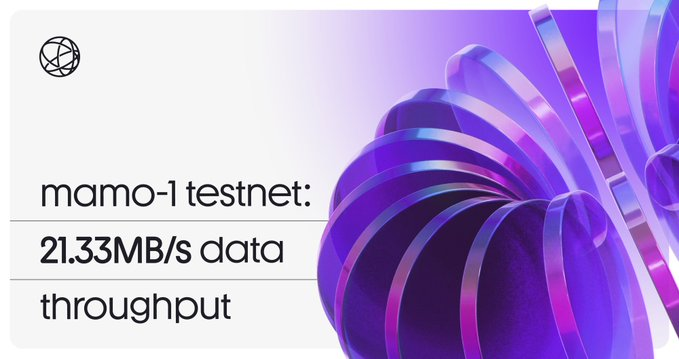The launch of the Celestia mamo-1 testnet
Blockchain technology is undergoing a paradigm shift from monolithic architecture to modular design, and the launch of the Celestia mamo-1 testnet marks a new stage in this evolution. On April 14, 2025, Celestia announced the official launch of its testnet, achieving for the first time a 128MB block capacity and 21.33MB/s permissionless data throughput—16 times the performance of the current mainnet. This breakthrough not only provides developers with a more efficient foundational infrastructure but also has the potential to fundamentally reshape the development logic of Layer 2s and fully on-chain games.

Technical Core: From Data Availability Layer to Throughput Revolution
Traditional blockchains are constrained by the scalability bottleneck of monolithic design. Celestia solves this by decoupling the execution, settlement, and data availability layers via modular architecture, allowing developers to focus on optimizing specific functionalities. The core innovation of the mamo-1 testnet is the Vacuum! protocol—a data propagation technology based on a “lazy broadcast” mechanism. This protocol allows nodes to transmit only necessary data shards instead of full blocks, reducing network redundancy by 47%.
Combining erasure coding and dynamic routing algorithms, mamo-1 maintains high stability even in a real distributed node environment (deployed across Amsterdam, Paris, and Warsaw). According to blockchain performance monitoring data from JuCoin, the testnet processed over 4.44 million transactions in its first week, with an average block propagation delay of less than 2.3 seconds—demonstrating its reliability under high-stress conditions.
Industry Impact: Who Benefits from High Throughput Architecture
The technical breakthrough of the mamo-1 testnet directly benefits three key use cases:
-
ZK-Rollup Developers: By integrating Celestia’s data availability layer, ZK proof generation efficiency increases by 40%, while storage costs drop to 1/8 of traditional solutions.
-
Fully On-Chain Game Engines: Enables real-time uploading of large-scale game asset data (such as 3D models and dynamic scenes), advancing the experience of fully on-chain interactions.
-
Cross-Chain Protocols: With standardized data shard interfaces, multi-chain state synchronization speeds reach the millisecond level, providing foundational support for tools like JuCoin’s cross-chain asset aggregator.
It is worth noting that the mamo-1 testnet does not pursue theoretical peak performance alone, but emphasizes verifiable practicality. For example, its “Pull-Based Broadcast Tree” (PBBT) mechanism allows nodes to restore data integrity within 10 seconds after a disconnection—significantly reducing validator maintenance complexity and lowering barriers for small and medium nodes to participate in network governance.
Future Outlook: The Modular Roadmap Toward 1GB/s
The Celestia team has positioned mamo-1 as a “midway station” on the path to 1GB/s throughput. The Vacuum! protocol, validated in the current testnet, is expected to be integrated into the mainnet in Q3 2025, with block capacity upgraded to 512MB. In the longer term, Celestia plans to implement a fractal scaling strategy—applying differentiated scaling solutions at various layers (e.g., L1 focusing on security, L2 prioritizing throughput)—to build multidimensional scalability.
For developers, this evolution means lower on-chain data storage costs and greater customization flexibility. For instance, mamo-1 already supports developers in creating private database rollups through the gmamo.vercel.app interface, with custom data encryption rules—tools like these will significantly reduce the development threshold for Web3 applications.
The essence of modular blockchain competition lies in the efficiency of the data availability layer. The Celestia mamo-1 testnet, through verifiable technical benchmarks, demonstrates its comprehensive advantages in throughput, cost, and flexibility—redefining industry standards. As more ecosystem projects join the testnet and validate its performance, we may witness a paradigm shift from “on-chain computation” to “on-chain data services.”




